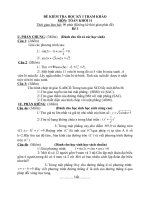Calculus 3 4: chuỗi số
Bạn đang xem bản rút gọn của tài liệu. Xem và tải ngay bản đầy đủ của tài liệu tại đây (325.2 KB, 28 trang )
Infinite Series and Differential Equations
Nguyen Thieu Huy
Hanoi University of Science and Technology
Nguyen Thieu Huy (HUST)
Infinite Series and Diff. Eq.
1 / 12
Fourier Series
Let f (x) be defined on R, periodic with period 2L, and piecewise
continuous on (−L, L).
∞
a0
nπx
1 Is there any series of the form
+
an cos nπx
such
L + bn sin L
2
n=1
∞
a0
nπx
an cos nπx
+
∀x ∈ (−L, L) ?
that f (x) =
L + bn sin L
2
n=1
2 Suppose such a series as above exists, is it unique?
Definition
Let f (x) be as above. Then, the series of trigonometric functions
L
∞
a0
nπx
1
+
b
sin
in
which
a
=
+
an cos nπx
f (x) cos nπx
n
n
L
L
L
L dx for
2
n=1
−L
all n = 0, 1, 2, · · · ; bn =
1
L
L
−L
f (x) sin nπx
L dx for all n = 1, 2, · · ·
is called the Fourier Series of f .
The above-defined numbers an , bn are called Fourier Coefficients of f .
Nguyen Thieu Huy (HUST)
Infinite Series and Diff. Eq.
2 / 12
Dirichlet’s Theorem
Let f (x) be periodic with period 2L, and piecewise continuous on (−L, L).
Suppose that f (x) exists and is piecewise continuous on (−L, L). Then
the Fourier series of f is convergent for all x ∈ R to the following sum
∞
a0
nπx
=
an cos nπx
+
L + bn sin L
2
n=1
f (x)
if f is continuous at x,
= 1
if f isn’t continuous at x,
2 (f (x + 0) + f (x − 0))
where an and bn are Fourier coefficients defined as above.
Nguyen Thieu Huy (HUST)
Infinite Series and Diff. Eq.
3 / 12
Dirichlet’s Theorem
Let f (x) be periodic with period 2L, and piecewise continuous on (−L, L).
Suppose that f (x) exists and is piecewise continuous on (−L, L). Then
the Fourier series of f is convergent for all x ∈ R to the following sum
∞
a0
nπx
=
an cos nπx
+
L + bn sin L
2
n=1
f (x)
if f is continuous at x,
= 1
if f isn’t continuous at x,
2 (f (x + 0) + f (x − 0))
where an and bn are Fourier coefficients defined as above.
Remark.
1) For even function f , the function f (x) cos nπx
L is even, and function
nπx
f (x) sin L is odd, therefore,
L
an = L2 0 f (x) cos nπx
L dx ∀n = 0, 1, 2, · · · ; bn = 0 ∀n = 1, 2, · · · .
Nguyen Thieu Huy (HUST)
Infinite Series and Diff. Eq.
3 / 12
Dirichlet’s Theorem
Let f (x) be periodic with period 2L, and piecewise continuous on (−L, L).
Suppose that f (x) exists and is piecewise continuous on (−L, L). Then
the Fourier series of f is convergent for all x ∈ R to the following sum
∞
a0
nπx
=
an cos nπx
+
L + bn sin L
2
n=1
f (x)
if f is continuous at x,
= 1
if f isn’t continuous at x,
2 (f (x + 0) + f (x − 0))
where an and bn are Fourier coefficients defined as above.
Remark.
1) For even function f , the function f (x) cos nπx
L is even, and function
nπx
f (x) sin L is odd, therefore,
L
an = L2 0 f (x) cos nπx
L dx ∀n = 0, 1, 2, · · · ; bn = 0 ∀n = 1, 2, · · · .
2) For odd function f , the function f (x) cos nπx
L is odd, and function
f (x) sin nπx
is
even,
therefore,
a
=
0
∀n
=
0, 1, 2, · · ·
n
L
2 L
nπx
bn = L 0 f (x) sin L dx ∀n = 1, 2, · · ·
Nguyen Thieu Huy (HUST)
Infinite Series and Diff. Eq.
3 / 12
L
3) For 2L-periodic function g we have −L g (x)dx =
any real constant c. Therefore,
c+2L
an = L1 c
f (x) cos nπx
L dx ∀n = 0, 1, 2, · · ·
1 c+2L
nπx
bn = L c
f (x) sin L dx ∀n = 1, 2, · · ·
for any real constant c.
Nguyen Thieu Huy (HUST)
Infinite Series and Diff. Eq.
c+2L
g (x)dx
c
for
4 / 12
L
3) For 2L-periodic function g we have −L g (x)dx =
any real constant c. Therefore,
c+2L
an = L1 c
f (x) cos nπx
L dx ∀n = 0, 1, 2, · · ·
1 c+2L
nπx
bn = L c
f (x) sin L dx ∀n = 1, 2, · · ·
for any real constant c.
Example.
Nguyen Thieu Huy (HUST)
Infinite Series and Diff. Eq.
c+2L
g (x)dx
c
for
4 / 12
L
3) For 2L-periodic function g we have −L g (x)dx =
any real constant c. Therefore,
c+2L
an = L1 c
f (x) cos nπx
L dx ∀n = 0, 1, 2, · · ·
1 c+2L
nπx
bn = L c
f (x) sin L dx ∀n = 1, 2, · · ·
for any real constant c.
Example.
Nguyen Thieu Huy (HUST)
Infinite Series and Diff. Eq.
c+2L
g (x)dx
c
for
4 / 12
Nguyen Thieu Huy (HUST)
Infinite Series and Diff. Eq.
5 / 12
Nguyen Thieu Huy (HUST)
Infinite Series and Diff. Eq.
5 / 12
Nguyen Thieu Huy (HUST)
Infinite Series and Diff. Eq.
6 / 12
Nguyen Thieu Huy (HUST)
Infinite Series and Diff. Eq.
6 / 12
Example 2:
Nguyen Thieu Huy (HUST)
Infinite Series and Diff. Eq.
6 / 12
Nguyen Thieu Huy (HUST)
Infinite Series and Diff. Eq.
7 / 12
Nguyen Thieu Huy (HUST)
Infinite Series and Diff. Eq.
7 / 12
Nguyen Thieu Huy (HUST)
Infinite Series and Diff. Eq.
8 / 12
Nguyen Thieu Huy (HUST)
Infinite Series and Diff. Eq.
8 / 12
Definition [Half-range Fourier Series]
A half range Fourier sine or cosine series is a series in which only sine
terms or only cosine terms are present, respectively.
Nguyen Thieu Huy (HUST)
Infinite Series and Diff. Eq.
8 / 12
Definition [Half-range Fourier Series]
A half range Fourier sine or cosine series is a series in which only sine
terms or only cosine terms are present, respectively.
When a half range series corresponding to a given function is desired, the
function is generally defined in the interval (0, L) [which is half of the
interval (−L, L), thus accounting for the name half range].
Nguyen Thieu Huy (HUST)
Infinite Series and Diff. Eq.
8 / 12
Definition [Half-range Fourier Series]
A half range Fourier sine or cosine series is a series in which only sine
terms or only cosine terms are present, respectively.
When a half range series corresponding to a given function is desired, the
function is generally defined in the interval (0, L) [which is half of the
interval (−L, L), thus accounting for the name half range]. Then the
function is specified as odd or even, so that it is clearly defined in the
other half of the interval, namely, (−L, 0).
Nguyen Thieu Huy (HUST)
Infinite Series and Diff. Eq.
8 / 12
Half-range Fourier Sine Series
Let f be defined on (0, L) and satisfying Dirichlet’s conditions. Extend f
to an odd function f˜ on (−L, L) by putting
f (x)
if x ∈ (0, L),
f˜(x) :=
−f (−x) if x ∈ (−L, 0).
Outside (−L, L), f˜ is periodically extended to R. Then, Fourier coefficients
of f˜ (hence of f ) are an = 0 ∀n = 0, 1, 2, · · · ;
L˜
L
f (x) sin nπx dx = 2
f (x) sin nπx dx ∀n = 1, 2, · · · .
bn = 2
L
0
Nguyen Thieu Huy (HUST)
L
L
0
L
Infinite Series and Diff. Eq.
9 / 12
Half-range Fourier Sine Series
Let f be defined on (0, L) and satisfying Dirichlet’s conditions. Extend f
to an odd function f˜ on (−L, L) by putting
f (x)
if x ∈ (0, L),
f˜(x) :=
−f (−x) if x ∈ (−L, 0).
Outside (−L, L), f˜ is periodically extended to R. Then, Fourier coefficients
of f˜ (hence of f ) are an = 0 ∀n = 0, 1, 2, · · · ;
L˜
L
f (x) sin nπx dx = 2
f (x) sin nπx dx ∀n = 1, 2, · · · .
bn = 2
L
0
L
L
0
L
Half-range Fourier Cosine Series
Let f be as above. Extend f to an even function f˜ on (−L, L) by putting
f (x)
if x ∈ (0, L),
f˜(x) :=
f (−x) if x ∈ (−L, 0).
Outside (−L, L), f˜ is periodically extended to R. Then, Fourier coefficients
L˜
L
of f˜ (hence of f ) are an = 2
f (x) sin nπx dx = 2
f (x) cos nπx dx
L
0
L
∀n = 0, 1, 2, · · · ; bn = 0 ∀n = 1, 2, · · · .
Nguyen Thieu Huy (HUST)
Infinite Series and Diff. Eq.
L
0
L
9 / 12
Example
Nguyen Thieu Huy (HUST)
Infinite Series and Diff. Eq.
10 / 12
Example
Nguyen Thieu Huy (HUST)
Infinite Series and Diff. Eq.
10 / 12
Nguyen Thieu Huy (HUST)
Infinite Series and Diff. Eq.
11 / 12









